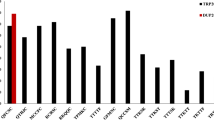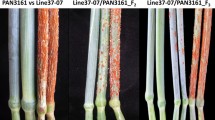Abstract
Rust diseases caused by Melampsora spp. represent a major threat to the productivity of short rotation coppice (SRC) willows grown for biomass, causing yield losses of up to 40%. The routine use of fungicide in SRC plantations is not a viable option because of economic and environmental considerations; thus, breeding for rust resistance is a major target for willow breeding programmes. To characterise the genetic basis of rust resistance in willow and provide targets for use in future marker-assisted selections, quantitative trait analyses were performed using a large full-sib mapping population (K8) which segregates for rust resistance and several other important agronomic traits. Rust resistance in field conditions was assessed in three consecutive years. For a more detailed genetic dissection, laboratory inoculation tests using isolates of two distinct and prevalent pathotypes (LET1 and LET5) were also performed. For field-based resistance, a major quantitative resistance locus, designated SRR1 (Salix Rust Resistance 1), was detected in addition to several quantitative trait loci (QTL) of more modest effect. Inoculation test data also supported an important role for SRR1. Specific interactions between particular rust isolates and different QTL were detected, and QTL that only influenced resistance in field conditions were identified. The QTL reported here represent an important basis for the future development of markers for use in willow breeding programmes. As the linkage map for the K8 population is anchored to the Populus trichocarpa genome sequence, a more efficient marker development for future fine-scale mapping and candidate gene identification is possible.




Similar content being viewed by others
References
Åhman I (2007) Rust scorings in a plantation of Salix viminalis clones during ten consecutive years. Eur J Forest Pathol 28:251–258
Beavis WD (1994) The power and deceit of QTL experiments: lessons from comparative QTL studies. Proceedings of the 49th Annual Corn and Sorghum Industry Research Conference, Washington, DC, ASTA
Cervera MT, Gusmao J, Steenackers M, Peleman J, Storme V, Vanden Broeck A, Van Montagu M, Boerjan W (1996) Identification of AFLP molecular markers for resistance against Melampsora larici-populina in Populus. Theor Appl Genet 86:301–307
Cullis BR, Gleeson AC (1991) Spatial analysis of field experiments —and extension to two dimensions. Biometrics 47:1449–1460
Cullis BR, Gogel BJ, Verbyla A, Thompson R (1998) Spatial analysis of multi-environment early generation variety trials. Biometrics 54:1–19
Dowkiw A, Bastien C (2004) Characterization of two major genetic factors controlling quantitative resistance to Melampsora larici-populina leaf rust in hybrid poplars: strain specificity, field expression, combined effects, and relationship with a defeated qualitative resistance gene. Phytopathology 94:1358–1367
Dowkiw A, Husson C, Frey P, Pinon J, Bastien C (2003) Partial resistance to Melampsora larici-populina leaf rust in hybrid poplars: genetic variability in inoculated excised leaf disk bioassay and relationship with complete resistance. Phytopathology 93:421–427
Gleeson AC, Cullis BR (1987) Residual maximum likelihood (REML) estimation of a neighbour model for field experiments. J Agric Biol Environ Stat 2:1–25
Gullberg U, Ryttman H (1993) Genetics of field resistance to Melampsora in Salix viminalis. Eur J Forest Pathol 23:75–84
Hanley SJ (2003) Genetic mapping of important agronomic traits in biomass willow. Ph.D. thesis. University of Bristol, UK
Hanley S, Barker JHA, Van Ooijen JW, Aldam C, Harris SL, Åhman I, Larsson S, Karp A (2002) A genetic linkage map of willow (Salix viminalis) based on AFLP and microsatellite markers. Theor Appl Genet 105:1087–1096
Hanley S, Mallott MD, Karp A (2006) Alignment of a Salix linkage map to the Populus genomic sequence reveals macrosynteny between willow and poplar genomes. Tree Genet Genomes 3:35–48
Johansson LKH, Alström S (2000) Field resistance to willow leaf rust Melampsora epitea in inter- and intraspecific hybrids of Salix viminalis and S. dasyclados. Eur J Plant Pathol 106:763–769
Jorge V, Dowkiw A, Faivre-Rampant P, Bastien C (2005) Genetic architecture of qualitative and quantitative Melampsora larici-populina leaf rust resistance in hybrid poplar: genetic mapping and QTL detection. New Phytol 167:113–127
Kohler A, Rinaldi C, Duplessis S, Baucher M, Geelen D, Duchaussoy F, Meyers B, Boerjan W, Martin F (2008) Genome-wide identification of NBS resistance genes in Populus trichocarpa. Plant Mol Biol 66:619–636
Lander ES, Botstein D (1989) Mapping Mendelian factors underlying quantitative traits using RFLP linkage maps. Genetics 121:185–199
Larsson S (2001) Commercial varieties from the Swedish willow breeding programme. Asp Appl Biol 65:193–198
Lefèvre F, Gouè-Mourier MC, Faivre-Rampant P, Villar M (1998) A single gene cluster controls incompatibility and partial resistance to various Melampsora larici-populina races in hybrid poplars. Phytopathology 88:156–163
Lehmann EL (1975) Nonparametrics. McGraw-Hill, New York
Lescot M, Rombauts S, Zhang J, Aubourg S, Mathe C, Jansson S, Rouze P, Boerjan W (2004) Annotation of a 95-kb Populus deltoides genomic sequence reveals a disease resistance gene cluster and novel class I and class II transposable elements. Theor Appl Genet 109:10–22
Maliepaard C, Van Ooijen JW (1994) QTL mapping in a full-sib family of an outcrossing species. In: Van Ooijen JW, Jansen J (eds) Biometrics in plant breeding: applications of molecular markers. Proceedings of the 9th Meeting EUCARPIA Section Biometrics and Plant Breeding. Plant Research International, Wageningen, pp 140–146
McCracken AR, Dawson WM (1998) Short rotation coppice willow in Northern Ireland since 1973: development of the use of mixtures in the control of foliar rust (Melampsora spp.). Eur J Forest Pathol 28:241–251
McCracken AR, Dawson WM, Watson S, Allen CY (2000) Pathotype composition in Melampsora epitea populations occurring on willow (Salix) grown in mixed and monoculture plantations. Eur J Plant Pathol 106:879–886
Newcombe G, Bradshaw HD, Chastagner GA, Stettler RF (1996) A major gene for resistance to Melampsora medusa f. sp. deltoidae in a hybrid poplar pedigree. Phytopathology 86:87–94
Parker SR, Royle DJ, Hunter T (1993) Impact of Melampsora rust on yield of biomass willows. In: Abstracts of the 6th International Congress of Plant Pathology, Montreal, Canada, 28 July–6 Aug 1993, National Research Council Canada, Ottawa, ON, Canada, p 117
Patterson HD, Thompson R (1971) Recovery of inter-block information when block sizes are unequal. Biometrika 58:545–554
Pei MH, Royle DJ, Hunter T (1996) Pathogenic specialization in Melampsora epitea var. epitea on Salix. Plant Pathol 45:679–690
Pei MH, Hunter T, Ruiz C (1999) Occurrence of Melampsora rusts in biomass willow plantations for renewable energy in the United Kingdom. Biomass Bioenergy 17:153–163
Pei MH, Yuan ZW, Hunter T, Ruiz C (2000) Heterogeneous nature of a ‘new’ pathotype of Melampsora rust on Salix revealed by AFLP. Eur J Plant Pathol 106:771–779
Pei MH, Lindegaard KN, Hunter T, Ruiz C (2001) Preliminary studies of inheritance of rust resistance in biomass willows. Asp Appl Biol 65:281–288
Pei MH, Lindegaard K, Ruiz C, Bayon C (2008) Rust resistance of some varieties and recently bred genotypes of biomass willows. Biomass Bioenergy 32:453–459
Pei MH, Ruiz C, Shield I, Macalpine W, Lindegaard K, Bayon C, Karp A (2010) Mendelian inheritance of rust resistance to Melampsora larici-epitea in crosses between Salix sachalinensis and S. viminalis. Plant Pathol 59:862–872
Pinon J, Frey P (2005) Interactions between poplar clones and Melampsora populations and their implications for breeding for durable resistance. In: Pei MH, McCracken AR (eds) Rust diseases of willow and poplar. CABI, Cambridge, pp 139–154
Robinson DL, Thompson R, Digby PGN (1982) REML—a program for the analysis of non-orthogonal data by restricted maximum likelihood. Proceedings in computational statistics, part II (supplement). Physica, Vienna, pp 231–232
Rönnberg-Wästljung AC, Gullberg U (1999) Genetics of breeding characters with possible effects on biomass production in Salix viminalis (L.). Theor Appl Genet 98:531–540
Rönnberg-Wästljung AC, Samils B, Tsarouhas V, Gullberg U (2008) Resistance to Melampsora larici-epitea leaf rust in Salix: analyses of quantitative trait loci. J Appl Genet 49:321–331
Searle SR, Casella G, McCulloch CE (1992) Variance components. Wiley, New York
Stirling B, Newcombe G, Vrebalov J, Bosdet I, Bradshaw HDJ (2001) Suppressed recombination around the MXC3 locus, a major gene for resistance to poplar leaf rust. Theor Appl Genet 103:1129–1137
Tsarouhas V, Gullberg U, Lagercrantz U (2002) An AFLP and RFLP linkage map and quantitative trait locus (QTL) analysis of growth traits in Salix. Theor Appl Genet 105:277–288
Tsarouhas V, Gullberg U, Lagercrantz U (2004) Mapping of quantitative trait loci (QTLs) affecting autumn freezing resistance and phenology in Salix. Theor Appl Genet 108:1335–1342
Villar M, Lefèvre F, Bradshaw HDK, Tessier du Cros E (1996) Molecular genetics of rust resistance in poplars (Melampsora larici-populina Kleb./Populus sp.) by bulked segregant analysis in a 2 × 2 factorial mating design. Genetics 143:531–536
Yin TM, DiFazio SP, Gunter LE, Jawdy SS, Boerjan W, Tuskan GA (2004) Genetic and physical mapping of Melampsora rust resistance genes in Populus and characterization of linkage disequilibrium and flanking genomic sequence. New Phytol 164:95–105
Yin T, DiFazio SP, Gunter LE, Zhang X, Sewell MM, Woolbright SA, Allan GJ, Kelleher CT, Douglas CJ, Wang M, Tuskan GA (2008) Genome structure and emerging evidence of an incipient sex chromosome in Populus. Genome Res 18:422–430
Zhang J, Steenackers M, Storme V, Neyrink S, Van Montagu M, Gerats T, Boerjan W (2001) Fine mapping and identification of nucleotide binding site/leucine-rich repeat sequences at the Mer locus in Populus deltoides ‘S9-2’. Phytopathology 91:1069–1073
Acknowledgements
This work was funded by the Department of Trade and Industry’s Renewable Energy Programme, UK (Agreement No. B/W6/00599/00/00), and later as part of the BEGIN (Biomass for Energy Genetic Improvement Network) project (UK Department of Environment, Food and Rural Affairs (Defra)—project no. NF0424). We also acknowledge additional funding support from the Biotechnology and Biological Sciences Research Council of the United Kingdom’s Institute Strategic Programme Grant for Rothamsted Research’s Centre for Bioenergy and Climate Change. Rothamsted Research is an institute of the Biotechnology and Biological Sciences Research Council of the UK.
Author information
Authors and Affiliations
Corresponding author
Additional information
Communicated by W. Boerjan
Rights and permissions
About this article
Cite this article
Hanley, S.J., Pei, M.H., Powers, S.J. et al. Genetic mapping of rust resistance loci in biomass willow. Tree Genetics & Genomes 7, 597–608 (2011). https://doi.org/10.1007/s11295-010-0359-x
Received:
Revised:
Accepted:
Published:
Issue Date:
DOI: https://doi.org/10.1007/s11295-010-0359-x




